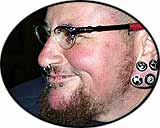
WARNING: This article contains explicit photographs. Michelle, “The Pass Around Girl”
After I posted photos of “Michelle, The Pass Around Girl” and her extremely direct and explicit tattoos on ModBlog, it generated a flurry of comments and debate about them. Were they part of a D/s relationship? Were they self-abuse or derogatory in some way? Michelle, an educated (she has a Masters Degree in English) and STD-free sex addict and cancer survivor, answered a few questions for us via email. You can also watch out for her in November when the interviews she did with Dr. Phil and Dr. Keith Ablow should air.
|
Search Results for: publisher's ring
Post navigation
Who owns my body? [The Publisher’s Ring]

|
“Nothing is legal with body hacking — so what!?! Why should we respect laws made by people who still believe that man should be like god made him? Why should we respect laws made by people who want to take the control of our destiny?”
– Lukas Zpira
In a recent ModBlog entry I featured someone who’d had a skin removal scar done, which then keloided out of control, constricting his chest and negatively affecting mobility. Instead of going to a doctor or attempting non-surgical options, he chose to have two very experienced body modification practitioners cut off the keloids and stitch him back together (as seen in our scar repair gallery). From a risk point of view the procedure was arguably no more dangerous (perhaps even less, because of the wound closure) than a larger scarification project, let alone implants, tongue splitting, transscrotal piercings, and other common heavy modifications. To ensure healing went went, the practitioners stayed with the client (who was a practitioner himself) for a week afterwards, monitoring the process, and making sure he had full aftercare and treatment. As I write this the procedure is a success and the client is very happy with the results.
However, the two artists found themselves faced with enormous criticism accusing them of having irresponsibly “crossed the line” into medical territory, thereby endangering the client needlessly and putting others in the industry at risk should there be a legal snap-back if anything went wrong — which to me seems about as valid as telling gay men they can’t hold hands in public because it’ll freak out the heterosexuals, causing them to vote against gay marriage. Even though the reaction was likely a bit knee-jerk because the photos were quite graphic, there is some truth to the suggestion that the procedure may have been legally “medical” in nature because scar treatment is something doctors do and consider their territory. So even though in terms of difficulty or risk the procedure was less than almost all surgeries, it could have still caused a legal problem.
Depending on the nation it was done in, a wide range of charges could have been (and still could be) laid, including variations on practising medicine without a license and assault charges. Had the procedure been erotic in nature (subincision or castration for example), additional charges could be laid against media and websites posting photos and discussion of the procedure, including obscenity charges and record-keeping charges (for example, an American site has the legal obligation to share full identification information on the people in all photos of this type with the US government — thus BME is hosted outside of the US).
This all raises an interesting political question — why can’t I ask anyone to perform a “medical” procedure on me? Sure, I might be better off if I went to a doctor. But is it right to force me to go to a doctor? Do I not have the right to make the “wrong” decision? If not, why is it not my choice? It’s not as if I’m asking for the right to drunk drive or some other “wrong” decision that’s going to hurt others — I am asking only for the right of self-determination.
All human rights emerge from the belief that ultimately an individual has the right to choose their own destiny, and as such, all human rights and freedoms are built on the statement that we own ourselves. However, this runs contrary to the legal answer to the question I posed, because I can’t ask just anyone to do the procedure — I can only ask those who are approved by the government, and they usually have the legal obligation to refuse me if the procedure is in any way atypical.
“When there’s another person, if it’s a medical professional, you’re asking someone who is following the rules of the land to do something which, if it’s brand-new, has to be authorized by committee after committee after committee after committee and whatnot so he doesn’t get charged with manslaughter or assault and doesn’t lose his license.”
– Dr. Robert H. Stubbs, MD FRCSC FACS
So if I ask a doctor to do an atypical procedure, they are legally obligated to refuse (unless they’re willing to spend years justifying your case to their superiors). If I ask a friend to do it, they face a variety of criminal charges if they do it. If I do it myself, I risk medical imprisonment (psychiatric commitment, a process by which I can be permanently stripped of all my rights, and medicated against my consent to the point where I can’t defend myself). And if I do somehow get it done, and decide to talk about it publicly, I (or the hosting website that publishes my story and pictures) can be criminally charged for doing so. I think it should be very clear that there are broad limits as to our ownership of our own bodies, with the government determining what we are permitted to do and have done, and by whom.
In this sense, heavy body modification is an active form of political resistance against a system which seeks to make us prisoners under the guise of “protecting” us. Perhaps you agree that most of the time the government is right. Perhaps you are even correct most of the time. But that puts you in a position to help guide people, not to force them to submit to your opinion when it comes to their decisions about themselves. Forcing people under threat of prosecution and imprisonment to make decisions that “they’re better off” making is a slippery slope. Instead of arguing as to where to draw the line in terms of how much freedom the government should “give” people, what we should be arguing about is whether the government even has the right to draw a line telling us how much of ourselves we control and how much they control.
Actually, I’m not even willing to even have the debate — it’s black and white as far as I’m concerned. You can’t be “mostly free”. Mostly free equates to slavery. I’d rather make mistakes as free individual than be successful as a slave (that said, my intention is to be successful as a free individual!). Tell me that’s nonsensical all you want, or that maybe big brother knows better, but I’ve made lots of good decisions, and lots of bad decisions, and I value them all as a part of my life experience. I own myself, and I don’t need to be protected from myself. When I need help from the government, I’m comfortable asking for it. I’m not comfortable having it forced on me.
There are already many laws in place to protect us from the actions of others. A person who claims to be a doctor or otherwise misleads customers about their background can be charged. A person who abuses minors or engages in predatory behaviour (sexually, financially, or otherwise) can be charged. Negligence charges and many others can be used in the case of problematic or abusive practitioners. As far as I’m concerned the only laws in the realm of “practising medicine without a license” should have to do with people pretending to be doctors in name. The specifics of the procedure are irrelevant.
But when it comes down to it, the statement is quite simple:
I own myself. I can leave myself as I am, or I can improve myself as I see fit, or I can even choose to destroy myself. It’s my decision, and my decision alone. Any law that tells me that I don’t own myself, and can’t dictate what is done to by body and by whom, is fundamentally wrong and by definition a tool of those who would enslave others. Worse yet, it belies a flawed foundation upon which true human rights cannot be built.
Until society concedes total individual self ownership, freedom and rights are but a smokescreen.

Shannon Larratt
BME.com
Another two months of magnetic implants [The Publisher’s Ring]
 Another two months of magnetic implants |
“Man could escape danger only by renouncing adventure, by abandoning that which has given to the human condition its unique character and genius among the rest of living things.”
Most years I publish an “April Fools” article here on BME (articles like Adding and Subtracting, Joshua, The Raelians, and Love at First Bite). This year I’d like to write about dealing with the aftermath of something arguably foolish instead. As you know, last year I had magnets implanted in my fingertips in order to allow me to sense electromagnetic fields. While I’ve been very happy with them on the sensation end of things, as I left off with the last article, it appeared that one of the magnets had started to break down after its silicone coating was damaged by opening a pickle jar wrong (please read that original article first if you have not already).

Since that writing, as you can see above, the other side of my hand got similarly irritated (although no trauma that I know of occurred to initiate it as it had on the first problem) and started to blacken and become uncomfortable. I also started seeing photos of magnets taken from other people’s bodies which had significantly broken down — here is, I believe, what is happening:



The magnet starts as a small gold-coated neodymium (rare earth) magnet encased in a thin bubble of silicone. These magnets are tiny (about a third the size of a grain of rice), so the coating is extremely fragile in parts. It doesn’t take much for it to become compromised, and with only a tiny gap (as seen in the middle picture), the body starts to break down the magnet, extracting the substances it can use and trying to encapsulate those that are toxic. Not long after (within weeks if not less), the magnet is almost completely broken down and becomes a loose powder of toxic elements surrounded by bits of silicone. At this point it has of course also lost its magnetism so it is no longer functional either.
Because the effects of neodymium exposure of this type are relatively unknown, and in other circumstances the substance is known to be cytotoxic, mutagenic, and carcinogenic, and because it was somewhat painful, I believe it made sense to have them removed. I asked my friend Tom Brazda to do the extraction — he’s the only person I’d trust to do this (and I suspect there are few piercers who know him and his work that wouldn’t put him on a top five body piercers of all time list).
On to the gory details. Be warned that these pictures are graphic.

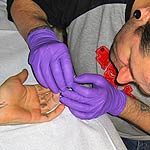
In the first picture we’re applying a topical anesthetic to my finger. The glove-cot contraption is on because the anesthetic needs to be applied without coming in contact with the air. In the second shot Tom is doing a final check of my finger and marking the location of the implants. While four implants had been originally installed, only two appeared to be there eight months later.


My suspicion is that the set slowly migrated together. I believe this shifting has caused them to appear as two, and I also believe that it’s possible that this shifting, which would have caused the two units to vibrate against each other, may have accelerated the breakdown of the silicone.
Oh, and at about this point I got a phone call from a friend urging us to consider aborting the removal… She’d had her doctor (a GP) remove hers, and he cut down toward it, reached in to grab it, and it just fell to pieces… He backed out and referred her to a plastic surgeon. So far she has kept it, and three months later her finger is very discolored (far more than mine was), and still quite sore. She did however mention that she found a clinical reference to neodymium — it is at times used in laboratory mice to extend their lifespans. Hmm… Maybe it’s not so toxic after all?
Naw, better safe than sorry I think!

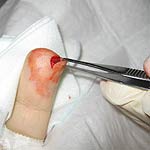
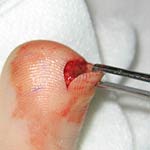
Anyway, we began cutting a flap over the more recent and more irritated of the two magnets. Rather than just cutting down and spreading the skin and trying to pull it out, the plan was to make a cut that would let us just fold open the skin over the implant and remove it either by excision, scraping it off, or irrigating it out depending on the consistency. We couldn’t be sure what the specifics of the procedure would be until we actually got in there.
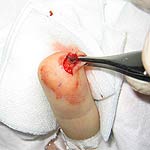
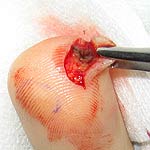
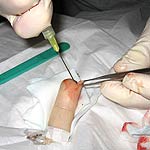
The top half of one or two of the magnets pretty much just fell out (you can see one in the first picture), but we were left with a largely empty cyst-like shell made up of and surrounded by blackened tissue. There were some loose flakes and powder but most seemed to be a part of the spongy mass of scar tissue. Irrigating it didn’t move anything, and it was completely adhered to the flesh around it, so there was no way to grab it and pull it out. All we could do is cut all around it and remove it as a single piece.
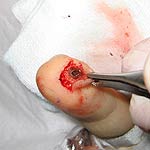
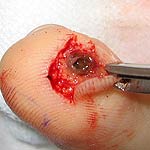

Some healthy tissue was removed, but the majority (if not all) of the toxic material from that side appears to be gone.
Going into the second side (the older of the two compromised sides) we encountered a little different tissue. The implant also sat quite a bit deeper in the flesh; deep enough that we couldn’t be completely sure at the time there wasn’t another hidden behind it (and while I think it’s gone, I won’t be entirely certain what’s left until the healing is done).
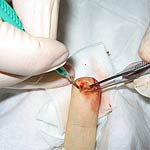
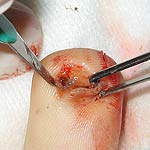

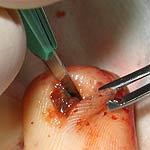
When we’d dug down deep enough to expose it, the good news was that the cyst was quite well developed. It was rooted in place a little, but we were able to pull it out without significant damage to the surrounding fingertip and with minimal excision of healthy flesh. It was seriously gross though seeing these really vile and rotten looking blobs coming out of my finger!

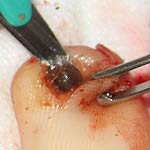
Now, with my fingertip completely exposed, but finally clean, it was time to stitch me back together, and we were done. I’ve been very stressed out over these problems, and it felt so good to see those sutures going in and knowing this was almost over.

My only regret is that we accidentally threw away the removed tissue and magnet bits as we were disinfecting the workspace. I’d hoped to take a much closer look at the magnet, but unfortunately that “oops” moment killed that. I can however share with you a magnet that rejected from the finger of a friend of Steve Truitt after about four months. This one has barely broken down, but the silicone is gone from one side, part of the gold coating has eroded, and the inner core has started to decompose.
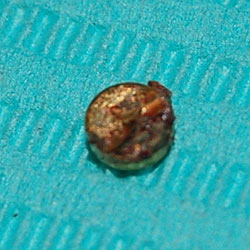

Some people’s bodies will reject the magnets like a splinter (the lucky people), other bodies will try and encapsulate them, others will try and break them down, or a combination of all of these strategies. Internal body chemistry will also greatly affect how quickly the process happens.
I’m treating the wound with Neem pills and a Neem spray and so far it appears to be healing quite well. My right hand, which also contains magnets (but in a stacked configuration and with a thicker coating of silicone), so far has experienced no problems. In fact, it’s gotten more sensitive over time and I find myself becoming more and more aware of the electromagnetic environment around me (for example, noticing “hot spots” in power cables and couplings that are leaking radiation into the air)… But, I think it’s only a matter of time before that stack is compromised as well, and as sad as it will be to remove them, I think I have to take them out as well.
Talking to Steve Haworth and others, it sounds like a significant percentage of the small magnets implanted in people are already breaking down. It’s effectively a defective product, not even safe enough for a year in the body, let alone a lifetime. Steve tells me he’s considering ceasing sales of his smallest units (they are currently for sale on eBay), but honestly, especially given that we’ve known now for months that they’re not very stable, I feel that it needs to go a step farther and a recall needs to be issued for all of the silicone coated magnets that are out there. I do not believe that any of them will remain stable in the long term, and I believe that all of them will break down in time as I’ve described here.
One of the problems with body modification these days is, well, BME and the internet in general… When someone comes up with a great new idea like these magnetic implants (and it is a great idea), it’s instantly posted, and everyone wants it right now. But now, because of that rush, there are dozens of people, many not inside the body modification industry (so they’re without easy access to removal, let alone monitoring), that need surgery that could have been averted with a proper testing cycle.
I’d like to propose that for volatile implants and other procedures that can have unforeseen effects on the body, that these procedures should be limited to people working inside a studio or otherwise able to go to the studio the practitioner works in on a nearly daily basis. These things need to be aggressively monitored and documented so the risks are thoroughly known before they move into the client sphere. It’s one thing when we endanger ourselves as professionals inside this industry, but it’s another thing if clients who may not understand that the risks are not fully known are put into that same danger.
When I receive photos to BME, for every thousand fresh photos I receive perhaps one hundred healed photos… Of the two, it’s the healed photo that has more value. Think surface piercings — you can do a crazy corset with rings and it looks great fresh, or a forearm piercing with a straight bar and it looks great fresh too, but good luck getting a healed photo. Furthermore, for every healed photo I get, I get one problem photo (that is, a photo of a serious complication). I think because when people get a body modification others tell them it’s a stupid thing to do and too dangerous, so when things go wrong, there’s often a sense of shame and embarrassment… So they hide that the problem happened, and other people repeat their mistakes because they were unaware of the risk.
Let me be very clear about this: things go wrong all the time. It’s part of the game. But when things do go wrong, rather than hiding it, we need to share everything we know about the problems so they are less likely to happen to someone else.
In this magnetic implant procedure, one main simple thing went wrong: the magnet is not stable in the body, and the coating provided was not a sufficient permanent barrier between the magnet and the body. For existing people, I again strongly urge removal — and don’t kid yourself into thinking that because yours hasn’t broken down yet that you should be able to keep it. If yours hasn’t broken yet, thank your lucky stars that removal is going to be much simpler!
For people who’ve not gotten magnets implanted, I really have to emphasize that implanting this style of magnet with a thin silicone sheath, knowing what we now know, is reckless to the point of being stupid, since it simply doesn’t work. The initial product has turned out to be defective — but I believe we can still make this work. Glass (like an RFID) won’t work because the magnet can’t be exposed to heat without de-magnetizing it. There are however other polymers such as polyurethane (used to coat artificial hearts) with better durability and good biocompatibility that can be applied and cured at room temperature. So don’t think the idea of giving humans magnetic vision is a dead one!
[Please be sure to visit the companion article to this by Jesse Jarrell; it’s a great explanation as to the thinking that went into the development, and also includes some of Jesse’s ideas as to why things have gone wrong and how they could be fixed.]
But let’s be sure that we take it slow, wait out a few people testing them before we go putting hundreds of experimental devices into people who can’t easily find removal options, and document our failures as well as our brilliant theories! There’s nothing wrong with taking risks, but taking needless ones is, well, foolish.
Proud to be tattooed? What’s there to be proud of? [The Publisher’s Ring]
 Proud to be tattooed? What’s there to be proud of? |
Well, you walk into a restaurantStrung out from the road And you feel the eyes upon you As you’re shaking off the cold You pretend it doesn’t bother you But you just want to explode Most times you can’t hear ’em talk Other times you canOh, the same old clichés “Is that a woman or a man?” And you always seem outnumbered You don’t dare make a stand – Bob Segar, Turn The Page
|
Being a modified person in an unmodified world can really suck, and genuinely brings truth to the expression “life’s not fair.” Most people think we’re a bunch of losers, and few of us work to change that perception.But still, I hear a lot of tattooed people (for the sake of simplicity, when I say “tattooed” in this article, take it to include people with any public mods that visually set them apart from the mundanes) say that they’re “proud to be tattooed”, or they’re proud to be a part of the tattooed community. Common slogans seen on t-shirts sold at tattoo conventions such as “the only difference between people with tattoos and people without is that tattooed people don’t care if you’re tattooed or not” imply not only an us-and-them stance, but the idea that we the modified are somehow “better”. The pages of my editorials here clearly have the same bias.
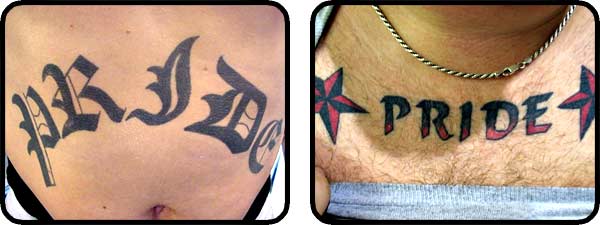
But what does it mean to have “modified pride” or to be “proud of your tattoos”? I often hear this coming from people with badly done tattoos that show minimal creativity or skill, and from people who do little to excel in life, thereby strengthening these stereotypes the mundanes already have about us. Pride (like respect) can be earned through achievement and dignity, or it can be seized with conceit as empty pride. When you hear someone say that they’re proud to be tattooed, what are they saying, and what exactly are they proud of? Do they have beautiful tattoos? Have they been successful as a tattooed person? Are tattooed people generally an over-achieving lot? Are we “the winning team”? Or are we no better than ignorant unemployed racists proud of our meaningless skin color?
The stereotype of a tattooed person is that of criminals, drug addicts, and chronic underachievers, and there is a statistical truth to that slander. Sadly, when it comes to people who choose to show those tattoos on public skin, the stereotype is often all too true. Not much to be proud of. That’s no surprise though — tattooed people are treated poorly by the majority; those who are not tattooed. The job market is much more difficult, we have to work harder for the same wages, we get poor customer service, we are shunned in mixed social groups, and are effectively a self-made minority and are treated as such. This stereotype remains because too many people with public tattoos and other mods continue to foster it — although we do plenty of whining about it, as if that could somehow change it. To make matters worse, too few who can shatter the stereotype stand behind their tattoos in the real world, choosing instead to hide them more with every promotion, thus reinforcing and giving a stamp of approval (or at least silent concession) to every prejudice they’ve faced themselves.
“If we were to wake up some morning and find that everyone was the same race, creed and color, we would find some other cause for prejudice by noon.”– George Aiken
Let’s be honest for a moment about what happens to most people when they get their hands or faces tattooed or pierced, or otherwise set themselves up visually as an outsider. If you do this, you will be harassed in public. People will make fun of you, and it will be the same insults and rude questions every day for the rest of your life. People will try and hurt you just for having chosen to look different than them. You will get poor service at restaurants, banks, and just about everywhere else. You will be turned down for jobs that you are more than qualified for. You will be turned down for loans that you have the credit rating for. If you work in the modification industry, governments will pass laws against your livelihood. If you have children, it will be harder to get them into a good school, and their teachers and other parents will abuse them because they don’t like the way you look. You and your family will have to work twice as hard and be twice as skilled to get the same amount of pay as people who fit the ignorant, ugly, mundane mold of the mainstream.
But these chosen hardships can be a foundation for strength — as Nietzsche put it (and he was far from the first or the last to say so), “that which does not kill me makes me stronger”. In the beginning of the 1960s, to many people, the Soviet Union had a broad lead in the space race. Even though US engineers had far less experience than the Soviets, and were working with the aid of computers no more powerful than a desk calculator, John F. Kennedy proposed that by the end of the decade — only eight years later — Americans would be walking on the surface of the moon, an almost laughably impossible ambitious goal. On September 12th, 1962 at Rice University he explained,
“But why, some say, the moon? Why choose this as our goal? And they may well ask why climb the highest mountain? Why, 35 years ago, fly the Atlantic? Why does Rice play Texas?We choose to go to the moon. We choose to go to the moon in this decade and do the other things, not because they are easy, but because they are hard, because that goal will serve to organize and measure the best of our energies and skills, because that challenge is one that we are willing to accept, one we are unwilling to postpone, and one which we intend to win, and the others, too.”
America did achieve this incredible goal*, Americans are still the only people to have achieved it, and their peaceful domination of space went a long way to defining America as a nation that inspired people around the world to shoot for the moon in their own way.
|
|
||
| * |
and they did it with the aid of an eccentric and very heavily tattooed engineer – Erl van Aken – but that’s another story!
|
|
It was the facing of difficult tasks (Herculean challenges might be a better term) and overcoming them that let this greatness bloom, and as well, in our own lives we need to choose the difficult path if we want to be great individuals. Heroes are nothing without challenge. We’re already starting down such a path by choosing to be publicly different than everyone else. The problem is that too few of us are also working to succeed. We’ve ridden off to war, but forgotten our swords at home, dull and rusty (luckily our opponents did as well). Hardship in and of itself does not bring greatness, but besting it can. These hardships of being publicly modified can be turned into successes. By facing challenges, we both avoid stagnation and allow ourselves to reach our potential.
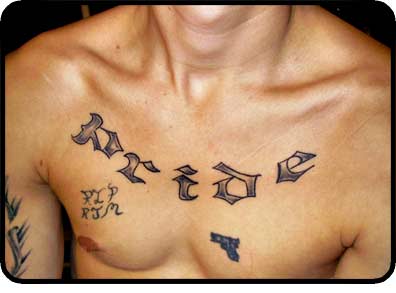
The biggest problem in this world is the unholy trinity of stupidity, laziness, and lack of critical thinking. It’s why the biggest, richest governments in the world, made up of multi-millionaire politicians, can continue to trick their impoverished masses into electing them over and over. The masses have spent the last hundred years being conditioned toward ignorance in order to allow them to be controlled (see my previous column on this subject) — which is why modern elections are popularity contests in which fact-free advertising determines the winner and actual debates on the core issues are rare, let alone voters going out and educating themselves independently. Movies and television sell as fact pop science devoid in reality, and movies like the upcoming King Arthur are called “true stories” and “historical dramas”, fallacies that even the most basic of understanding should shatter… but rarely does.
Seeing this, I’m hardly proud to be a human, if I’m to define myself by the actions of these masses. Luckily, I don’t, and if you’re reading this you probably don’t either. I’ve decided instead that the masses haven’t earned the right to call themselves humans. In their failure I see a playing field optimized for success for those who don’t fall prey to the pitfalls of the easy life of the modern wageslave. The modified have already broken one bond of the mainstream — but only one of many — by crossing that social line. While “safe” tattoos grow in popularity every day, we still have a long way to go before the average person can tattoo their face — and I am not at all convinced that the average drone will ever even want to do something like that…
So how can you succeed when you wear public marks that set you up to fail?
“Just as iron rusts from disuse, even so does inaction spoil the intellect.”– Leonardo Da Vinci
The answer is simple and found in old-fashioned common sense: work hard and educate yourself. If modified people need to be better than the mundanes just to get the same recognition, we should take it a step farther. Be the best. Win everything. No compromises. That’s really all there is to it. If you’re in school, work hard and get good grades. Excellent grades. If you need help, ask for a tutor, and instead of watching four hours of TV, study and read. Have fun doing it; learn to enjoy it. Go out and exercise. Get fit and build up every skill you possibly can. Learn to weld. Plant a garden. Take Judo. Anything. And do it as a proud tattooed person, and stand up for yourself when you’re challenged.
Take it a step farther and support other modified people who are willing to work hard as well. Seek them out if you’re in a position to hire people, and if you’re in a position to be hired, be so damn good at your job that no one can complain about the fact that you have customized yourself into a more ideal human, and are who you want to be. Be proud, but make sure you can back it up with something worth being proud of. Go out and actively change the world for the better.
If we all work hard to be successful and to break the preconceived notions people have about us, we can change the stereotypes. Maybe we can go even farther, and create a new stereotype. We need to wear our tattoos as war paint for victory, not as the brands of criminals and losers. But don’t forget Kennedy’s words — choose this path willingly because it is hard, not because it is easy. And it will be hard, and it will take a long time before you can reap the rewards of this adventure, but you have already won the first battle by choosing to break the bonds of conformity and becoming publicly modified. You can win the war as well.

Shannon Larratt
BME.com
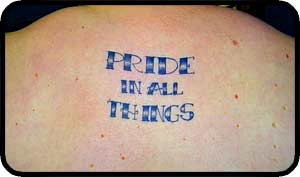
Free Online Resources
Since one of the ways the mainstream seeks to quash uprisings by those outside both the mundane and outside their elite control castes is financial pressure, you may be saying to yourself “but I can’t afford to even buy books to read.” You may already read the science blogs online and have discovered that they, like television, leave you with nothing but a shallow comprehension of a broad array of subjects, but without any real depth — sure it’ll help you win at Trivial Pursuit, but what good is shallow knowledge if you’re trying to genuinely understand a subject?
One of my favorite online “self improvement” sites that many people may have overlooked is Project Gutenberg (gutenberg.net). When the copyright on a book expires, Project Gutenberg works to make that book available to the public. Think of it as a free online library where you can read the classics — the books that over time we’ve decided were significant cultural contributions. It’s not going to be the same chuckle-factory as getting stoned and watching people making fun of oddballs on the WB Superstar, but are you looking for temporary amusement in life, or are you looking for knowledge, strength, and success?
And what’s stopping you from visiting your local library?
“Frederick Douglass taught that literacy is the path from slavery to freedom. There are many kinds of slavery and many kinds of freedom. But reading is still the path.”– Carl Sagan
The Gift of Magnetic Vision [The Publisher’s Ring]

|
It’s hard to deny that Steve Haworth (iam:steve haworth) has been one of the most influential and innovative voices in body art over the past decade. In the field of implants as sculptural art he has singularly defined the art form, and with the assistance of Jesse Jarrell (iam:Mr. Bones) has continued to escalate it into increasingly refined forms. I heard a rumor recently that they’d been experimenting with magnetic implants, and I thought to myself, “cool party trick”, and checked out the pictures on Steve’s page.
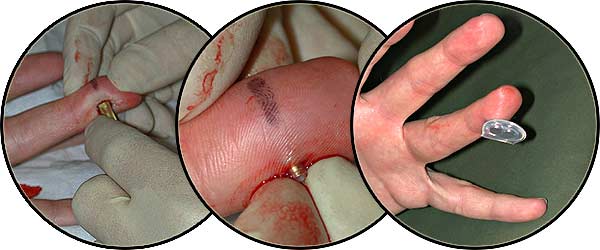
Photos of Todd’s implants being inserted by Steve, and showing them responding to a magnet.
Photos courtesy of Steve Haworth and Jesse Jarrell.
A fascinating letter from the client was posted along with it — he’d had a small silicone-coated neodymium magnet implanted, and it turned out to be far, far more than just a party trick!
|
|
Sensory Experimentation Somatosensory Extension
Reflections by Todd M Huffman [excerpt]
I am now able to perceive magnetic fields in ways not naturally possible. The sensation is different than holding a magnet, as the neurons are stimulated with a higher resolution. With the implant I can detect subtle changes in polarity and strength that I cannot when equipped with a magnet in the conventional manner. Yet the most significant observations have come from another property of implants, their relative permanence to exogenous artifacts. Being able to perceive magnetic fields has expanded my conscious perception of magnetic fields ‘in the wild’.
In one sensory incident, I was walking out of the library, and I sensed the inductive anti-theft device. I have walked in and out of dozens of libraries hundreds of times, and never once have I thought about the magnetic fields passed through me to prevent me from stealing a book. I have been intellectually aware of the mechanism, but never paid attention until now. Another time I opened a can of cat food for my girlfriend’s pets, and I sensed the electric motor running. My hand was about six inches away from the electric can opener, and I was able to sense where the motor was inside of the assembly. Again it brought my attention to a magnetic source that I understood intellectually, but would have otherwise been unaware of. I feel I am one step closer to fully grokking the reality I inhabit.
The experience of my implant is not nearly as rich as my visual or auditory sensation, but nevertheless after a week it has dramatically changed the way I think about my daily sensory experience. A small magnet embedded in a finger may seem like a trivial exercise. I find it difficult to explain the significance, somewhat akin to trying to explain to a blind person what it is to see. The problem isn’t defining the technical characteristics of the visual system, but one of trying to convey what conscious perception of certain wave frequencies does to the way a person conceptualizes the world.
In modifying my body I have ever so slightly altered the way I organize the world in my mind. I eagerly await the day in which I can integrate more elaborate senses into myself. With every passing minute I try to see radiant heat, hear radio waves, and think the thoughts of those that pass by. And by better understanding what I cannot feel, I can fully appreciate what I have now.
I was floored. This seemed to me to be one of the biggest steps body modification has taken. The notion of enhancing sensation is nothing new to anyone with genital modifications, but the idea of adding something fundamentally new to the function of the body is a radical concept that only a few people have done meaningful experiments in. I had to interview Todd about his experiences, and he was happy to help us out.
BME: Tell us a bit about yourself… Where are you from?
TODD: I grew up in Los Angeles and a small town, Teutopolis, in southern Illinois. When I was growing up my main interests were in emergency medicine. I started college studying nursing, with plans to continue on to medical school. While in high school I got my certification as a Nurses Assistant, and completed a course to be an EMT. These experiences are relevant because I was very thorough in my research on body modification, the effects of magnetic fields on tissues, implant construction, and the specific procedural skill of Steve Haworth (the implant artist who worked with me on the project).
I worked as a nurse’s assistant in the St. Louis University Hospital Neurology unit, where I developed my interest in neuroscience — and my aversion to medicine. I don’t dislike the medical profession per se; I just prefer an occupation with more freedom. I moved back to California to attend California State University at Long Beach and studied neuroscience. After graduation I took a job with the Alcor Life Extension Foundation (alcor.org), and will be working there for two years until I start graduate school.
One important aspect of my life is transhumanism. I have been identifying myself as a transhumanist since the age of thirteen, when I discovered the website of the Extropy Institute and the philosophical writings of Max More (maxmore.com) and Nick Bostrom (nickbostrom.com), among others. The transhumanist philosophy has provided a useful framework for me to build ideas and concepts upon, such as the concept and practice of attempting to extend my sensory experience.
BME: Did you have other modifications before this particular “upgrade”?
TODD: Before this my body modifications have been limited to piercing, both cosmetic and play. Our society has perfected the art of pain avoidance and disassociation from our bodies. Piercing and other body modifications bring the mind back to the body and increase a person’s awareness of their physical self. For such a materialistic society, America has lost touch with their physical self.
BME: So this the first “functional” modification you’ve gotten?
TODD: Yes. The magnetic implant is probably the crudest form of functional implant. It pales in comparison to much more complex implants that interface directly with neurons, such as cochlear implants. As a point of clarification, my magnetic implants are more effective as a conceptual tool, rather than for real world use. The plans were more for the exploration of sensory experience than for a specific task that would increase my functional abilities.
BME: For those that aren’t familiar, could you tell us a bit about cochlear implants?
TODD: Cochlear implants are a medical device that bypasses damaged structures in the inner ear and directly stimulates the auditory nerve, allowing some deaf individuals to learn to hear and interpret sounds and speech.
My involvement with cochlear implant research was analyzing the electrophysiological brainstem response of implant patients with a particular disease, auditory neuropathy. I did this for a semester as an independent project, and the bulk of my time was spent in front of a computer working with numbers. However I did on several occasions assist in the data collection procedures, and talked with people who had cochlear implants. I was fascinated with the possibility of gaining a sense with technology that was forbidden by nature.
Fortunately I have all the senses normally accorded to a human being. Current medical devices are not capable of giving me additional sensory experiences. Steve Haworth, Jesse Jarrell, and I were discussing various implants, and Jesse mentioned a friend of his who got a steel sliver in his finger and could sense speaker magnets. Jesse and I had previously discussed implanting magnets, and the idea was born. I was highly motivated to get the implant because of the possibility to explore a new sensory modality.
BME: How did you refine the idea into something functional?
TODD: I spent several months researching magnetic implants. I was concerned the magnet would attract iron particles from degraded red blood cells and cause irritation in the surrounding tissue. A significant amount of research has been done by the medical field and my concerns were alleviated. After that Jesse and I ordered a batch of neodymium magnets from a supplier and played with size combinations. After determining the sizes and shapes of the desired implants, Jesse made several prototypes. Jesse and I tested the implants to make sure the coatings were sufficient, and Jesse made the implant that was actually implanted.
BME: How was the healing?
TODD: Healing was great. I had feeling back by the next morning, and full sensitivity back in a week. The scarring is minimal, and is not noticeable unless you are looking for it. The next day my finger felt like I had slammed it in a car door, but that is expected. There has been no prolonged discomfort.
BME: Is the implant visible?
TODD: Not visible at all. If someone palpates my fingertip and knows exactly where the implant is they can feel it. A friend of mine couldn’t find it until I pointed out the location.
The goal was to have it as unobtrusive and natural as possible. The reason for this was not to hide the implant from other people, but to hide it from myself. I want the sensation to seem as naturally endogenous as possible. I want the sensation to integrate as much as possible with the rest of my sensory experience.
BME: How does it feel to you in the absence of a magnetic field?
TODD: I feel nothing, just like any finger experiencing normal conditions. Humans ignore the majority of sensory experience, a necessity given the barrage of information thrown at us by reality.
BME: And when you move into a magnetic field, what does it feel like?
TODD: There are two distinct feelings I get from fields. For a static field, like a bar magnet, it feels like a smooth pressure. Imagine running your hand slowly through lukewarm water, and brushing your finger across the top of a large invisible marshmallow. That is the closest description I can give. Oscillating fields, such as electric motors, security devices, transformers, et cetera, vibrate the magnet. This sensation is much more sensitive and noticeable.
BME: How sensitive is? Can you tell the direction of a field?
TODD: The implant is rather sensitive. I can tell the polarity of a bar magnet from several inches away. So far the furthest I have felt an oscillating field has been about two and a half or three feet. That was the security system in a video store, which uses magnetic induction.
BME: You can “feel” for anti-theft devices? You’re getting all the super-villains excited!
TODD: All you would-be criminals don’t get your hopes up. I can only detect the active components of anti theft devices — those stands by the exits of stores. The actual component inside the item does not generate its own field. I just get a buzzing feeling when going through security systems.
BME: How “fine” a sense is it? Does it feel like a sense like sight or hearing, or more like a “sixth sense” in that it’s more of a “gut” or instinctual sense?
TODD: The feeling is rather fine. I can detect different frequencies in the magnetic fields. I haven’t done experiments yet to determine the sensitivity range, but I will in the near future. The sensation is rather intuitive, and exploring a magnetic field is not unlike trying to identify an object with your eyes closed.
BME: Does it feel like a sense in and of itself, or is it more of an “interface” between a sensory device and your nervous system?
TODD: The implant does not feel like an ‘alien’ artifact, it is much closer to a natural sense. When the sense is not active I don’t feel the implant and don’t really think about it. If the sensation were coming from an external source, it would feel much more like an interface object rather than an actual sensory experience.
BME: Will you expand this to your other fingers as well, or do you feel that wouldn’t add to the experience? I’m having visions of mechanics that will be able to run their fingers over an engine and diagnose problems because of imperfections in the magnetic fields.
TODD: I don’t think this type of implant will ultimately prove to be useful. However, my intentions were exploratory, and the case may be that this type of implant has many more uses. There are a few ideas I have that may involve adding more implants.
BME: Do you have plans to add other senses as well?
TODD: I would like to add as many senses as I possibly can. One area I am considering is using the implant, and others as needed, as a form of haptic feedback. Computer interaction is developing at a snail’s pace, whereas almost every other index of computer development is racing at exponential rates. Our main form of computer input — the keyboard — is over a hundred years old. Even the mouse is over thirty years old. Monitor technologies have progressed very slowly, and are fundamentally the same as they have always been. I don’t expect everyone to go out and get magnets implanted in their fingers, but as a society we need to think outside the box and devise new ways to interact with computers.
BME: Are you finding that it is having a functional impact on the way you perceive and interact with the world?
TODD: The implant has changed my perception of the world around me in a small but significant way. Information is constantly flowing around us, and we remain blissfully unaware of most of it. Having a tiny bit of that data stream pulled into your conscious awareness is a shocking experience. Functionally I have changed very little, but I am now more aware of what it is I don’t feel. There is an untold amount of information flowing around us that we don’t experience; my implant makes me think about this more.
BME: Did you do any psychological (or other) preparatory work before the implant?
TODD: Before the actual implant there were several months of planning and hypothesizing, and thus I was well prepared for the procedure and the implant. There were unexpected sensations, and some sensations were missing I thought would be noticeable. I can’t say I would recommend any particular preparation, as a person willing to put implants into themselves should be able to handle small changes in their sensory paradigm.
BME: Can I ask a little about your research work for Alcor, and how that relates to this implant?
TODD: Alcor and the body modification community have a lot in common. The classic members of both communities are individualists with strong personal identities. Neither group is afraid to push the envelope of what is accepted by the populace around them. Transhumanism is a philosophy that does not encompass all members of both communities, but I have noticed a significant level of overlap. I think this is the case because transhumanism as a philosophy encourages exploring boundaries and transforming yourself.
Alcor employs me as a Research Associate, and I am part of the research and development team. My main task is to research and evaluate methods of preserving and storing neural tissue. My research at Alcor is unique because no other organization is concerned with preserving tissue in the manner we are. The research is significant not only to cryonics, but a lot of our research has applications in other areas, such as organ transplantation and storage.
All of this ties together because ultimately I am interested in pushing the boundaries. Pushing boundaries is, in my opinion, the quintessential characteristic of humankind. An a priori acceptance of the status quo on the part of our ancestors would leave you and I as naked apes hiding in the trees, or more likely, extinct. Both cryonics and body modification are controversial and exciting, just like writing or forging metal or flying.
BME: How did you meet Steve and Jesse, and what made you decide to work with them, rather than working with a doctor or more traditional medical team?
TODD: Jesse I met at a Los Angeles Futurists meeting, where we were attending a talk by Syd Mead. Later I met Steve through Isa Gordan, an artist in the Phoenix area.
As Steve and Jesse became friends with me, we discussed body modification and my medical background, and Steve allowed me to observe several procedures. Steve’s protocols for infection control and cross contamination avoidance are on par with a hospital setting, and I felt confident in his technical abilities. In addition, there is a high level of artistic vision in implant work, which I do not think can be met by conventional medicine.
BME: So there were advantages to doing it without the constraints of the medical industry?
TODD: Steve and Jesse provide the professionalism and concern for safety provided by traditional medicine while incorporating artistic vision and skill. Doctors, even cosmetic surgeons, would have likely shied away from doing this type of implant work. The fear of the unknown would dissuade most doctors from assisting me in the project.
BME: Any advice for people considering adding this sense or others?
TODD: Exploring sensory experience is a fundamental quality of human beings, be it through implants or pharmaceuticals or technology. Before any experimentation you are obligated to yourself to perform thorough research into the subject, as it is very easy to harm yourself. Personal responsibility is even more important than experimentation.
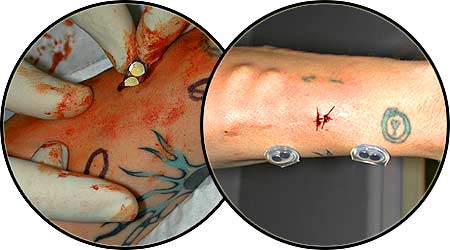
Jesse’s own magnetic implants, for utility rather than sensation.
Photos courtesy of Steve Haworth and Jesse Jarrell.
Thank you to Todd for taking the time out to talk to us. If you’d like to contact him, you can do so via email at odd1 at onebox.com. If you are looking to have this procedure or one like it done yourself, contact Steve Haworth via stevehaworth.com.

Shannon Larratt
BMEzine.com
CLASH: This is Omo Valley [The Publisher’s Ring]

CLASH: This is Omo Valley |
The urge to create, the urge to photograph, comes in part from the deep desire to live with more integrity, to live more in peace with the world, and possibly to help others to do the same.– Wynn Bullock
Recently BME had the opportunity to attend the opening of Liam Sharp‘s gallery show CLASH, being hosted at the Alliance-Francaise at 24 Spadina Road in Toronto (a two minute walk north from Spadina Station for TTC riders) — the show will continue there every day until January 10th.
The show featured photographs from his very recent trip to inner Ethiopia where he had the opportunity to photograph members of the Hamer tribe and others around the Omo valley that still practice ancient forms of body modification. We managed to pull Liam aside for a few minutes at the show and talk to him about his experiences.

BME: The thing that really surprised me is that you could still photograph activities like the big lip stretching — when I see it in books, it seems like it was disappearing forty years ago, but these are young people with these modifications. Was it hard to find them?
Liam: The reality is that there are very few areas still doing these things. It’s more and more difficult. I was just talking to someone that lived in Africa and he said that twenty, forty years ago you could just go outside the city and there’d be tribal peoples…
But even now, one thing you have to remember is that these cultures, these countries, are still extremely tribal. In fact, their governments are biassed in terms of tribes…
BME: As in for them, or against them?
Liam: Well both… The politicians represent certain tribes, so they’re slanted one way or another. That’s why there are coups and all these political problems — because the politicians really only protect the tribes they’re from. The tribes are identities or countries in and of themselves.
BME: With their own languages…?
Liam: They have their own languages a lot of the time, and also there are traditions you can see. There are three predominant tribes in this particular show — I visited about seven in all, and there are maybe fifteen in that one area. The Omo Valley region might be two hundred and fifty square kilometers. It’s not a huge area.
BME: How large are the individual tribes?
Liam: The Hamer tribe is about ten thousand people.
BME: So large enough that you never have to leave… you can stay inside the tribe, marry inside the tribe, and so on.
Liam: I think that’s how it’s done. I was photographing a guy from the Hamer tribe, the guy with the grip on the gun —
BME: I assume those are their guns? You didn’t ask them to pose with them?
Liam: No, no, of course not.
So I told him we’re going to this village in Oromati, and he said, “there’s no way I’m going there, if I step foot in that village, I’m dead!” since the Oromo are fighting the Hamer. The territories are extremely well defined, and they’re all kind of land-locked within those territories.
BME: They’re agricultural peoples?
Liam: Yes, very agricultural. But the terrain is extremely arid… I will never eat fried goat meat again — that’s all I was fed out there! Cows and goats, that’s it.
BME: How did you get there?
Liam: I was really kind of shit scared going on this trip… I sort of chickened out, but it’s important to do it this way and I always do it this way, which is to hire a local guide. I hired a truck with a guy — you can’t get there otherwise. The great thing about the guide is that he’s been in that area, and he knows the people, so he can smooth things over…
BME: Is that what he does? Just brings Westerners in?
Liam: That’s what he does… but in the whole time I was there I saw maybe five Westerners. So I’m not the only one, but there are very few… The others were there just to go I think, not to take photos other than just a few clips. That was one of the problems I think — their expectation that I would just take a few snapshots.
BME: How did they feel about professional photos being taken? Why did they think you were there?
Liam: That was always a big problem because my guide was always very suspicious of me. “Why are you taking these pictures? You’re going to make money from these pictures?”
And the fact is, as you can see, it’s not about the money. For me it was about going there and documenting these people, these tribal people, the way they live, and the way they are right now. But they didn’t like it. They wanted money — that’s what it was. I had to pay them three Birr, which is about forty-five cents Canadian per image [ed note: Liam took about 5,000 photos while on this trip]. Every time I clicked the camera, I had to pay. We had a suitcase full of money and my guide would just be paying it out.
BME: Isn’t that a bit dangerous?
Liam: It is… but it’s perfectly fine. You know why? Because paying money takes everything off the table. I’m going there and I’m giving them money and it’s an exchange. I’m taking their picture and they’re getting money. So it’s OK. That’s not a problem.
There was a situation when I was in the Omorati area, and photographed an older person, and the person collapsed
Are we going to get out of this situation, I was wondering? My guide said that if the old man had died, they’d have assumed the flash of the camera killed him — that this process, which they don’t understand, has killed this person. As soon as it moves to “you killed one of us” then very soon after it becomes “why don’t we kill you?” It’s very simple.
Luckily we ran over, and I supported him, and he was OK — but we got the hell out of there real quick!
They don’t particularly like the photographers. I really rode on the coattails of the relationship of my guide with the chiefs. As soon as that started to wear thin (which happened very quickly) I had to get out of there.
BME: Did you stay with the tribes, or just sort of roll into town, do your thing, and roll out?
Liam: We had a process — eventually it became repetitive and I was worried about that. What would happen is we would come into town, talk to the chief, and pay him off. As my guide was paying off the chief, I’d set up the backgrounds, set up the lights, and then he would tell everyone we were shooting and this is what the price was, and all that. Then I would just point to people in the crowd, and they’d come and I’d shoot them. One, two, three frames, and then the next person.
BME: They were OK with that?
Liam: They were OK, but it didn’t take long before they realized this was more than someone just taking pictures. They wanted to know what we were doing, what they were for — there was a big suspicion. I’m getting it here at the gallery too — questioning why I would want to portray Africa like this.
BME: One of the overwhelming comments I’ve heard walking around the show tonight is stuff like “oh, how disgusting they look” and “that one is even more mutilated than that one!” Does it seem strange to you that someone would come to your show and then say things like that?
Liam: No, not at all… That’s the biggest problem I’m had with going to places like this in the world. Westerners always look from this perspective, and that doesn’t respect these tribal peoples’ perspective. The fact is these people aren’t Canadian, they’re not living in this environment, and they don’t have the same culture. You can’t expect them to have our values and conduct themselves — or want to conduct themselves — like we do.
People are always asking me, “how could you take a picture of someone with a gun, how could you do this?”
The fact is that is how they are. That’s their culture, and that’s how they want to be! It’s just as ludicrous for them to wear clothes!
BME: You didn’t ask them to take their clothes off and paint their faces like that?
Liam: NO!!!! None of that is acting… That’s exactly —
THAT’S — HOW — THEY — WERE!
That’s it. That’s how they were.
\
|
Earlier we’d been joined by Roseanne Bailey, an African-Canadian woman, also a photographer who had lived and worked in Africa for some time. She expressed deep and very valid concerns that perhaps Liam was producing some kind of “savage erotica” akin to early exploitation films — and that by decontextualizing his subjects he might actually be doing them a disservice (basically a nice way of accusing him of being a racist and perpetuating the sins of colonialism because of his show).
|

2003 APP EuroCon Report [The Publisher’s Ring]
 2003 APP EuroCon Report
Going to my first APP convention, their recent EuroCon in Amsterdam, I didn’t really know what to expect. It’s been many years since I had any real dealings with the APP — fights over my support for scalpel piercing, dermal punches, and so on led me to believe that they were an overly conservative bunch of elitist piercers that weren’t particularly concerned with my “progressive” vision of the future of piercing. A few friends that “defected”, coupled with the APP’s continuing difficulty in drumming up much support from this community had me writing them off as not just useless but dead.    And then I went to EuroCon. After attending almost every single seminar, and getting to talk to the board members and piercers, my mind was most definitely changed. I now see the APP as an essential and positive group that I hope all piercers will support and take part in — we need the APP! Having seen what they’re trying to do, I believe that the APP has the potential to be the backbone of the industry, serving to educate piercers, unite piercers, and present a strong front in dealing with the government and the mainstream public. The convention also illustrated the need for groups like the APP in keeping piercers informed and up to date on the overwhelming range of professional issues that can be very hard to keep up on in the absence of reputable trade journals and other organizations.
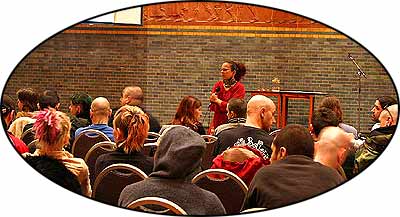 DAY ONE Rachel and I took an overnight flight, arriving the morning the convention started. We stopped at our hotel for a nap and got to the convention space at about noon where we were greeted by Bethra Szumski, the current APP president, as well as other familiar faces such as Alicia Cardenas of Twisted Sol in Denver, and Megg Mass of Infinite in Philadelphia. We’d missed the first class or two (bedside manner I think), but after lunch an anatomy course was scheduled. The anatomy class was being taught by Betsy Reynolds, an oral biologist who acts as somewhat of an advocate for the piercing community, counter-balancing some of the ludicrous statements made by anti-piercing dentists and so on. While the information she was presenting on healing was concise and relevant, I was a little surprised that it was being taught here at all — from my point of view it was disturbing that anyone wouldn’t know this anatomy in their sleep. The presentation was running slowly, in part because of constant interjections about piercing procedure. Eventually Paul King had to step in and ask that people save their procedure questions — this was an anatomy lecture and not intended as a technique debate. At the end of the first day I was still pretty convinced that it was going to be a waste of time. The anatomy course had been boring, basic, conservative, and Aimee (see sidebar) was doing her damndest to make the attendees look bad — or at least have a bad time. At the end of the day Rachel and I walked around town a little, stopped for a rather bland meal somewhere, went back to the hotel and went to bed.
DAY TWO Seminars in theory started at 9:30, so a little after 9 AM I arrived and was told the seminar — basic piercing technique — was pushed back until ten. Technical problems seemed to plague the event, and it wasn’t until 11:30 that things actually got started, with the technique seminar being bumped to the afternoon. I think the only good news, echoed by the people sitting around me, was that Aimee had decided to “skip class” that day, so at least we didn’t have to put up with her disruptions. Alicia then took over what was left of the morning with her stretching seminar. Given how basic the anatomy course had been, and because I’ve got more than a decade of stretching experience, I expected to be bored stiff — but I was very much mistaken! She started with diagrams showing exactly how stretching occurs on an anatomical level, detailing micro-tears and collagen replacement.
|
Also covered were stretching techniques, jewelry, and even lots of little tidbits for business owners like “stretching cards” (cards for your customers that encourage them to come back for slow and healthy stretching with incentives like 10% off on the next stretch if they wait). I do think Alicia has a little bit of an unfair bias against plastics, but she’s an engaging speaker that does a great job of covering basic material while throwing in enough trivia and advanced information to keep any level of audience enthralled.
After lunch, Bethra gave an in-depth and highly technical jewelry and metallurgy seminar. I was pretty tired at that point (still on Canadian time), and diagram after diagram of atomic structures was putting me to sleep. Since Bethra had prepared a hand-out with all the information, I took off for a nap. On my return she was just finishing up and Megg was about to start the basic techniques seminar, the technical problems having finally been solved.
 HANDOUT EXCERPT |
Megg’s also a great speaker and an experienced and progressive piercer who’s very good at presenting material that’s old hat to most people but with enough tips in it that I think even a piercing veteran would get a lot of out it, fine-tuning their techniques. Her seminar, prepared with Elayne Angel, contained numerous ideas that would improve any piercer’s work. Much of her seminar also focused on the subtle aspects of organizing a studio and its support staff to best facilitate and safe and pleasant piercing process.
 AT THE APP PARTY |
 AT THE APP PARTY |
|
 AT THE APP PARTY |
 COLD STEEL REPRESENTZ |
|
 BRUNO AND BRENNO |
 FRANCE REPRESENTZ |
|
 SO MANY RAFFLE TICKETS |
 AT THE APP PARTY |
DAY THREE
I showed up at 10 AM to again find that things had been pushed back even further — not so much for technical difficulties, but because people were simply late arriving. Maybe I’m a nerd, but if I had spent a few thousand dollars flying to a convention I’d go to the effort of showing up on time for the classes. I was surprised to hear that it’s not unusual at the Las Vegas convention for as many as half the people to not even bother showing up at all!
Meh.
The first seminar was one I’d wanted to take for a long time, the Bloodborne Pathogens course prepared by David Vidra and Health Educators, being taught by Alicia. This is one of those basic seminars that every piercer should know backwards and forwards, and like CPR certification, it’s the kind of thing they should be doing regularly to stay sharp. When it involves people’s lives — being able to provide a safe and aseptic foundation for your studio is the basis of this seminar — you don’t want to get sloppy!
  |
The presentation that followed was the one that really freaked me out and was probably the most eye-opening one of the event. Julien Ball of Prestige Medical, one of the leading autoclave manufacturers, gave an overview of modern sterilization technologies. It was fascinating to learn about the different procedures in Europe (for example, they use aggressive monitoring and charting of their clave’s performance, while spore tests are almost unheard of), but what really got to me was an overview of the difference between vacuum autoclaves and “normal” autoclaves.
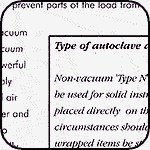   |
For those that don’t know, an autoclave sterilizes when the pressurized steam hits the surface of the items in the clave. If the steam doesn’t reach the items due to some blockage, sterilization doesn’t happen. Where it gets scary is that a simple pocket of air can, in some cases, provide this blockage. What that means is that a normal autoclave as is used by virtually 100% of North American studios can not guarantee sterilization of anything hollow (receiving tubes, tattoo tubes) or anything that has been placed in bags (basically all tools and jewelry) — there were definitely quite a few faces in that crowd turning white as Julien talked (see the handouts I’ve provided here for more information on this).
It was hard to get an answer out of Julien as to exactly what the risk level was — did these air pockets form every cycle, or one in ten thousand times? After all, Prestige Medical has a vested interest in the subject since there’s a higher profit margin in a $7000 vacuum clave than a $900 field-medic special! I was surprised to find out that about 70% of the piercers at the convention (the majority of the Europeans there) were using triple-pulse vacuum claves as well as single use water systems — some of the gear in the European studios was amazing. One German piercer even had an $8000 automated “tool dishwasher” in his shop!
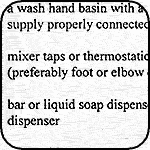 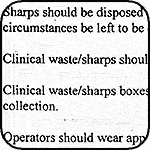  |
Al Prescott, organizer of the Derby conventions and developer of the Safe Working in the Tattoo and Piercing Industry vocational course, followed with an exhaustive seminar on risk management procedures which also touched on the extremely high standards that European (and specifically UK) studios are held to. I don’t think American or Canadian studios could match these without at least doubling prices — which might be a good thing since it could eliminate the low-end studios (although it could do the opposite since low-end studios tend to be more profitable and therefore more able to invest in new hardware).
The third day’s seminars ended with CPR certification which I skipped, but the day itself was to be capped with a party of everyone at the convention to give away some very generous prizes from the exhibitors — probably six thousand dollars worth of stuff was given away in the draws. Rachel won a belt buckle and some ring openers! I on the other hand won nothing…
 |
 |
 |
 |
 |
 |
DAY FOUR
The final day started with an aftercare presentation by Alicia, covering the pros and cons of a wide range of products in use by this industry. Unfortunately Aimee showed up about half way through it, shouting out a bunch of irrelevant questions which had already been discussed before she got there. I just don’t understand why someone would come all that way and act like such an ass… It was funny though — I think she must have clued in that she was pissing people off because when anyone would ask where she worked she was extremely evasive, just saying things like “a place on the east coast”.
Paul King’s informative and entertaining “amateur piercing anthropology and history” seminar followed. Paul is definitely a guy who I’d call a “piercing nerd” — someone who can go on and on about it and is interested in every little silly piece of trivia on the subject. Given that’s how I’d also describe myself, and given that it’s so hard for any one person to get a real picture of this community (so much of it is still oral history), it was wonderful to be able to assimilate his stories — many of which have been making their way into the new BME encyclopedia project (which will be officially unveiled on January 1st, 2004).
His stories about the rituals he watched during his travels in Penang were especially touching. We’ve all seen the gory photos of hundreds of thousands of people marching through the streets with giant cheek skewers — they seem so different from us — so enlightened. We are given the impression that they do these things naturally, and that everyone is in touch with God. That’s not entirely true though. Just like here in the West the occasional person will have to abort their suspension because they’re not ready to accept it, or it’s just not the right day, the same happens in Penang. I think the most moving photo I saw the whole time I was in Amsterdam was a young man sitting, emotionally exhausted, not able to take part in the ritual — and in his face I saw the same face I’ve seen in my backyard whenever someone asks to be pulled down from a suspension early because they can’t handle it.
It was at that moment, Paul said, that he realized that all of us in this world are the same.
Megg gave the final seminar, on legislation. I wasn’t sure how this was going to go over because some of the European piercers were already annoyed at the American bias on some of the subjects. However, the seminar didn’t talk specifics — its goal was to help teach people in down to earth terms how to deal with politicians. Given that Megg has helped Philadelphia come up with some of the best piercing legislation in the world, she’s more than qualified to teach this. Her anecdotes of her own successes in this area should be effective strategy for anyone around the world facing the same issues.
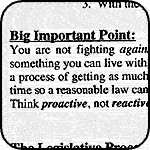 HANDOUT EXCERPT |
The day finished on a bit of a sad note though, as Bethra thanked everyone for coming, and let them know that, for financial reasons, this would probably be the last time the APP would host a European convention. However, the day before the convention started they’d hosted a mini-event introducing all of the heads of the fledgling European professional piercing organizations — some had only two or three members, but I think they walked away empowered, and thanks to seminars like Megg’s legislation one, with new plans of attack as well.
I think everyone there was looking forward to the day when we’re able to have a world piercing convention, hosted by dozens of professional groups from all over the world.
 MEXICO REPRESENTZ |
 BRUNO, CHRISTIANE, AND TEN YEARS OF PAIN |
 ALEX AND FOXX |
 MEGG MASS AND PAUL KING |
|
THE CONVENTION FLOOR
A small but nice cross-section of jewelry suppliers from around the world had booths at the event. Most of it was the same stuff that you’d see at every single tattoo convention — in all honesty I think they could have done without the floor. That said, I’d like to mention Quetzalli, an organic manufacturer from Mexico that had truly gorgeous examples of ammonite-inlaid ear jewelry as well as plugs filled with intricate and beautiful beadwork.
 |
 |
 |
 |
 |
 |
CONCLUSION
I met a lot of really wonderful people — a lot of old friends, online friends, and many new ones as well. Bruno and Brenno from Italy were wonderful — talented piercers and body artists full of enthusiasm in their fledging association. Christiane from Norway showed me Håvve’s new book, Ten Years of Pain, about the history of the Pain Solution performance art group (the book is wonderful and I hope to have it in BMEshop soon). Russ Foxx from Canada was great fun to see, as was Carlos Escobar of Spain. It was also nice meeting piercers like Alex from the UK who I knew from the good things their many clients I deal with all the time said about them.
I know I’m forgetting people! I apologize!
I also met with Andrea (Lacrima Rubra) from Germany who showed me video of years of her performances and introduced me to some new friends and other friends who — like so many of my acquaintances — I know only by their genital mods! I also got to see my old friend Patrick Bartholomew again which is always nice, and Kor (Ego Kornus) really impressed me as well. It was very interesting to talk to a performer who comes from an art (modern ballet) and ritual background more so than a body modification background. And the forty or so beers we drank that afternoon between us polished off that day very nicely!
I could name people endlessly and still forget some who made the event worthwhile for me, so I’ll get back to EuroCon itself. I had three main problems with the APP convention that I think to be fair I should mention. First, I thought parts of it were disorganized and unprofessional, resulting in things like handouts not being ready on time and projection systems not working — given the expense that had been gone to in hosting, and the fact that the attendees had spent a lot of money to come I thought this was unfortunate. That said, as someone who’s hosted events, I know this is pretty normal.
Second, I thought better fact checking could have been done. While the presentations given by specialists were very strong, some of the more general reports were riddled with historical errors, typos, and substitutions (naming the wrong soap as vegan and so on). They were just little things, but I felt that it’s that final touch that really makes a presentation perfect.
Finally, an exceptionally poor job was done in marketing and promoting the convention. Most of the European piercers I talked to had absolutely no idea there was an APP event in Amsterdam, and those that did assumed it was for Americans only and not oriented to Europeans. A lot of the value of the convention came from dialog with the attendees, not just the lecture sessions, so this mistake was their most serious.
Let me be very clear though — those complaints are listed in order to be thorough and honest. I do not believe that they tainted the conference to the point where it wasn’t worthwhile. While the majority of the information being presented was old hat to me, there were still volumes of knowledge being shoveled that was new and that I needed to hear — and that every piercer needs to hear.
The next APP convention — a much larger one that draws over a thousand piercers (some of the best in the world) — is at the start of May, 2004 in Las Vegas. Now, it happens to coincide with Shawn Porter’s wedding, so I’m going to have to miss a day, but assuming that America doesn’t stop me at the border, I’ll be there, eager to keep learning. I hope you’ll be there too.
See you in Vegas,

Shannon Larratt
BMEzine.com
PS. Thank you to the APP for inviting me to come and being generous enough to extend my press passes into the seminars. Thank you as well to Bethra, Megg, Paul, and the other APP members for making me feel welcome. Finally, thank you to them as well as Julien, Al, Betsy, and the other speakers for sharing their knowledge.
Does God Hate Your Tattoos? [The Publisher’s Ring]

Does God Hate Your Tattoos? |
“For no man ever yet hated his own flesh; but nourisheth and cherisheth it, even as the Lord the church.”
– Ephesians 5:29
|
Way back in 1995, about a year after starting BME, I received the following semi-literate email:
“I think you are doing is self mutilation and I for one am very disgusted. But there is hope for you! Read the BIBLE!”
It may come as a surprise that I actually have read the Bible, and it no more says “don’t get tattoos” than it says any number of other cultural concepts — not theological concepts — such as “spare the rod, spoil the child.” In fact, the Judeo-Christian family of faiths is full of tattooed and pierced characters, and parts of the Bible are very clear that extreme modifications — self-amputations even — are what God wants for some people. Under Christian theology, body modifications are like words — they’re tools. They can be used to bring glory to God and help live a good life, or they can do the opposite.

There are many parts of the Bible that mention piercing in passing since it was relatively normal in Biblical times, but the only passage that seems to even vaguely ban body modification — tattoos* in this case — is of course Leviticus 19:28, which reads,
“Ye shall not make any cuttings in your flesh for the dead, nor print any marks upon you: I am the LORD.”
|
* I should note that the original Hebrew text reads “k’thoveth qa’aqa”, or “writing that is stuck in”, usually used to refer to a form of modification closest to ink rubbing — a pagan funerary rite at the time, very different from modern tattooing. |
Leviticus is a book of laws telling the Jews of the time how to lead their lives. As such, the laws break down into three general types — first, laws regarding morality (bans on prostitution, bestiality, and so on); second, laws regarding health (advice on subjects such as food preparation — kosher laws); and third, laws to differentiate the Jews from the pagans (bans on certain rituals, haircuts, and so on). In the New Testament Jesus does away with these laws. That doesn’t mean that bestiality is suddenly OK, but it does give a modern Christian much more personal freedom in terms of things like the way they trim their beard and the way they choose to decorate their bodies, because they are now judged by their faith, rather than adherence to a set of hard and specific rules.
“Therefore we conclude that a man is justified by faith without the deeds of the law.”
– Romans 3:28“Let no man therefore judge you in meat, or in drink, or in respect of an holyday, or of the new moon, or of the sabbath days.”
– Colossians 2:16
This is explained perhaps more clearly in Galatians 3:23-24, which tells how Jesus replaced the old covenant with a new one:
“But before faith came, we were kept under the law, shut up unto the faith which should afterwards be revealed. Wherefore the law was our schoolmaster to bring us unto Christ, that we might be justified by faith. But after that faith is come, we are no longer under a schoolmaster.”
As well as the mention of tattooing or cutting in Leviticus, body piercing is also mentioned throughout the Bible. When the Israelites fought the Ishmaelites, Gideon told his warriors that they could take the golden earrings of the enemies they slew (Judges 8:24), and numerous passages mention the piercings of the Israelites as well (Exodus 32:3, Ezekiel 16:12, Isaiah 3:21, and so on). Other sections, in Deuteronomy 15 and Exodus 21 describe body piercing on servants (as a normal part of society), and nose piercing is described as beautifying and normal when Behuel and Nahor’s daughter is married in Genesis 24.
Sometimes Christians object to body modification on the basis of it defiling God’s creation — after all, 1 Corinthians 6:19-20 is fairly clear that the body is the temple,
“What? Know ye not that your body is the temple of the Holy Ghost which is in you, which ye have of God, and ye are not your own? For ye are bought with a price: therefore glorify God in your body, and in your spirit, which are God’s.”
Earlier, in 1 Corinthians 3:17, a dire warning is issued:
“If any man defile the temple of God, him shall God destroy; for the temple of God is holy, which temple ye are.”
The question is, what does “defile” mean?
I’ll spare telling you that the Catholic Church has already publicly proclaimed tattoos as acceptable, and that Crusaders were commonly covered in Christian tattoos in order to proclaim their faith and ensure a proper burial — A good way to understand what’s appropriate for a temple is to look at the range of Christian churches that history has produced. Until about the 10th century A.D., Christian architecture was largely reminiscent of earlier Roman buildings. In the Middle Ages huge Cathedrals dominated, covered in spires, sculptures, buttresses — anyone who’s been in these structures knows how overwhelmingly powerful they are psychologically.
The Gothic period produced churches with complex and intricate decoration and gorgeous glasswork. Centuries later in the Baroque era churches were less physically imposing, but were encrusted with wealth — golden opulence was used to manifest God. Other periods and areas have seen simple churches, small humble buildings relatively unadorned with the people themselves bringing the glory, and in modern times we’ve seen churches constructed in every conceivable style. We’ve even seen very successful temples built using nothing but television transmissions and a studio.
Marshall Mcluhan may be oft-quoted saying that the medium is the message, but in this sense, I think God might correct him and say, “No, Marshall, it doesn’t matter what the medium is — it’s the message that counts.”

I hope it’s clear that if we’re to speak in objective terms, that there’s no specific ban on body modification in the Bible, and that its value as something good in one’s a life versus its involvement in sin is very much determined by the way it’s being used — to put it another way, telling someone that their Christian tattoo is wrong would be no better than telling someone that praising God is wrong because someone else shouted blasphemies. Speech — and tattoos — are just a part of life. They can be right, or they can be wrong.
So a Christian certainly can’t go out and get a tattoo or other body modification if it leads to sin, or stands for sin, but modification — mutilation even — is acceptable if it helps the person lead a righteous life. Sex might be another good example. The Bible is full of things that could make a person believe that sex is a bad thing — prostitution, lusting after others’ wives, and forms of masturbation are all mortal sins. However, reading other parts of the Bible it’s clear that God intended sex to be something wonderful — but He wanted it to be used in the right context (a loving marriage under God).
“Thy two breasts are like two young roes that are twins, which feed among the lilies.
Until the day break, and the shadows flee away, I will get me to the mountain of myrrh, and to the hill of frankincense.
How fair is thy love, my sister, my spouse! how much better is thy love than wine! and the smell of thine ointments than all spices!
Thy lips, O my spouse, drop as the honeycomb: honey and milk are under thy tongue; and the smell of thy garments is like the smell of Lebanon.
A garden inclosed is my sister, my spouse; a spring shut up, a fountain sealed.
A fountain of gardens, a well of living waters, and streams from Lebanon.
Awake, O north wind; and come, thou south; blow upon my garden, that the spices thereof may flow out. Let my beloved come into his garden, and eat his pleasant fruits.
Open to me, my sister, my love, my dove, my undefiled: for my head is filled with dew, and my locks with the drops of the night.”– The Song of Solomon
It’s all about context. That which might be a sin when used against God is a beautiful thing when used for Him — it’s why a Christian couple can have a fulfilling and guilt-free sex life that involves bondage, anal sex, oral sex, Cleveland steamers, or whatever else makes them happy — as long as it’s loving and sanctifies the marriage bed (so no Cleveland steamers with the neighbors when the wife’s out of town!).
To give a more extreme example, eunuchs (castrated or even penectomized men) were common throughout various cultures in Biblical times, and hence came to be included in the Bible and were even embraced by several sects. The Byzantine Church had numerous eunuchs in ruling positions, and the Christian Coptic Church embraced castration as a holy path. While relatively common between 300 A.D. and 1,100 A.D., it continued in eastern Europe until surprisingly recently. Matthew 18:8-9 warns,
“Wherefore if thy hand or thy foot offend thee, cut them off, and cast them from thee: it is better for thee to enter into life halt or maimed, rather than having two hands or two feet to be cast into everlasting fire. And if thine eye offend thee, pluck it out, and cast it from thee: it is better for thee to enter into life with one eye, rather than having two eyes to be cast into hell fire.”
Matthew 19 continues, warning against adultry and other sins of the flesh, and in verse 12 says,
“There be eunuchs, which have made themselves eunuchs for the kingdom of heaven’s sake. He that is able to receive it, let him receive it.”
Even extreme body modification is permissable — if it’s done to serve God or to protect the individual from falling prey to sin or to God’s enemies. Of course, modern Christians on the whole believe this passage is “metaphorical”… but there’s certainly nothing that says that clearly, and if it’s metaphorical, how can one decide what else is as well? Many early Christian scholars such as Origen, considered one of the fathers of the faith, castrated themselves. A small number of patristic writers such as Tertullian actually referred to Jesus as a eunuch.
So what we see in the Bible is that Christianity has at best one highly vague ban on a specialized form of cutting, and then goes on to describe body piercing at length as normal, and even goes so far as to encourage extreme body modification when done for the sake of God. The New Testament contains one clear and overwhelming message: Love. Under Christian theology the whole point of God’s appearance on Earth as Jesus was to get rid of blind arbitrary rules, and replace them with a more fluid code of goodness.
“This is my commandment, that you love one another, just as I have loved you. Greater love has no one than this, that one lay down his life for his friends. You are my friends, if you do what I command you.”
– John 15: 12-14
I won’t get into it in this article in any depth, but the Bible also draws similar conclusions about ritual. In 1 Kings 18 and Mark 5 we hear descriptions of pagan sorcerers and priests performing rituals involving cuttings and bloodletting, but at the same time, Christian penitents and monks have been performing self-flagellation and even crucifixion in the name of their faith (Matthew 16:24) since the beginning — not a single early Christian church didn’t embrace these rituals and they are still popular in many areas such as Brasil and the Philippines. Again, it’s all a matter of what you’re using the tool to achieve.

Some Christians will warn others against involving themselves in tattooing or piercing because they perceive it as being sordid, using scripture such as Romans 12:17 to justify it,
“Recompense to no man evil for evil. Provide things honest in the sight of all men.”
However, it should be clear from the “double standards” in the Bible that God doesn’t believe that one should censor oneself because someone else has used a tool for evil. You can wield a sword in God’s army, or you can wield in as knight in Satan’s service — your final resting place is not determined by the sword, but by the army you choose to serve in. When Paul says in Philippians 4:8,
“Finally, brethren, whatsoever things are true, whatsoever things are honest, whatsoever things are just, whatsoever things are pure, whatsoever things are lovely, whatsoever things are of good report; if there be any virtue, and if there be any praise, think on these things.”
he isn’t saying to think of things that appear to be true, or appear to be honest, or appear to be just, pure, or lovely — he’s giving clear message in clear terms: be a good person and put Jesus above all else.
If you want to be a good person with tattoos, God will still love you. The Christian who tells you otherwise isn’t hearing the message for some reason and may need your help far more than you need theirs.

Shannon Larratt
BMEzine.com
PS. I am not a Christian, but if you’d like to meet other Christians interested in body modification, you can click here to meet them in the new BME Personals (or place your own ad), and there are of course many more on IAM — a few are linked in the interview above.
What’s in a Name? [The Publisher’s Ring]

What’s in a Name? |
'Tis but thy name that is my enemy;
Thou art thyself, though not a Montague.
What's Montague? It is nor hand, nor foot,Nor arm, nor face, nor any other part
Belonging to a man. O, be some other name!– Romeo and Juliet, Act II, Scene II
William Shakespeare
Much of who we are is defined by our community and our family. Our skills, interests, and our names are all chosen primarily by others while we were children and infants — modern body modification is a part of a larger set of actions that represent a significant step in human cultural evolution — the end of homogeneity.
The Internet has played a fascinating role in this shift through the seemingly innocuous requirement of asking people to choose usernames for their email, websites, and IM clients — what is this but an adult choosing to name themselves? Thus it is put into common consciousness the idea that one’s identity is self-defined, rather than externally assigned. There’s nothing stopping people from using their real name online, but how many people do you know that do that?
Until recently, online identities tended to be secondary — almost like secret identities — but as the line between the online world and the offline world blurs, the dominant identity takes control, and often that’s the online one. For those of you who’ve attended IAM BBQs and other offline events of online communities, you know that you are more likely to know people by their chosen name than their given name. As a result, name tags usually list the IAM name, and it’s very normal for people to refer to each other by those names in conversation — and often not even know the given name of their friend!
People with body modifications are already very used to a self-defined identity — an adult identity that’s different than the child identity — so it should come as no surprise that an increasing number of IAM members are legally changing their “real” names to match the identity they’ve created for themselves. Now, before you cringe at how weird this is, ask yourself: Are your friends the ones you chose, or were they assigned? Do you watch the movies you choose, or are they assigned? Do you wear the clothes you choose, or are they assigned?
Why should a name be any different?

Meet the Reverend Grenade Bee Of Death, who you may also know as iam:Grenade. When he married he took on his wife’s name with his own, and of course after their divorce it only reminded him of things he’d rather forget. He worked a solitary job, and over time most of his friends were people he met online, where while playing the game Planetarion he was known as The Holy Handgrenade of Antioch. Grenade came to be his regular online name, and when he started meeting online friends in person, no one could bring themselves to call him “Martin” — so the nickname Gren stuck.
The name Martin became less and less relevant as almost everyone called him “Gren”. After an epiphany as to the nature of people and friendship, and after time spent with good online friends he legally changed his name to Grenade Bee Of Death. After posting this to his IAM page, and explaining how easy it was, he helped a few others do the same.
I asked him whether he felt different with his new name and what he described was very similar to the amputee fetishists who when asked if they feel different without their legs reply, “no, now I feel normal!”
I find that there is very little difference, to be honest. Given that very few people need to use my surname in addressing me, and that people have been calling me Gren for a long time, I feel little change.I had to give my name to a policeman the other day, and I got the distinct impression he thought I was taking the piss, but he was very reasonable about it, just asking me for spelling.
On an emotional level it is kind of liberating, and in the same way that I embraced piercings and tattoos... it is something that I have chosen for myself. I think it's another thing that makes me feel more in control of my own life.
Obviously there are some elements of regret, in that I no longer carry my family name. I guess that if I change my mind later, then "change of name" is a fully reversible "mod"!
Now meet Swirly Wanx Sinatra, the first person to contact Gren about doing the same, formerly swirlywanx on IAM, now going by his full and legal name, iam:swirly wanx sinatra.

About two years ago “Daz” started realizing that blending in just wasn’t for him. While looking through large amounts of tattoo flash with an older brother he saw that it was mostly just commercial scribbles and commented, “that’s awful… just a load of swirly wank!”
The comment stuck, and when he joined IAM he did so as swirlywanx — of course at BBQs people had no idea he was actually Daz, and simply called him “Swirly”. At the same time his non-IAM friends started doing the same, and in jest started adding surnames and completing the identity. Soon he realized that he’d “grown into” Swirly, and after choosing “Sinatra” as a classy surname (“Wanx”, sounding too much like a down-on-his-luck pornstar, was demoted to a middle name) he legally became Swirly Wanx Sinatra.
Other than the occasional outburst from fools thinking he’s degrading Frank Sinatra, after a bit of checking that they’re not being messed with, people tend to respond with something along the lines of “that’s fucking cool… stupid as shit, but cool!”
Now meet RooRaaah Mew Crumbs.

For his whole life, Andrew Paul Johnson had been called Roo (on account of And-rew of course) — you know him on IAM first as AndyRoo, then RooRaaah, and now as iam:MisterCrumbs. He never liked his full name, and it didn’t feel right — “it just doesn’t fit with how I see myself.”
Starting with Roo, a friend a few years ago added “Raaah” and he liked it (“simple as that!”). “Mew” comes from his passion for cats, and his tendency to actually say “mew” a lot in conversation (“you have to experience it to appreciate the full greatness of how it sounds”). “Crumbs” as well comes from a quirk of his character and interests —
I think it stemmed from Danger Mouse... I'm not sure if you have seen it but Penfold used to say "Crikey crumbs sir!" when they were in a spot of bother, and it stuck with me.
Now that the change is complete, RooRaaah refuses to answer to “Andy” any more, and has spent the last while trundling around Liverpool changing his details. His workplace was incredulous and tried to refuse to accept the name change, but ultimately they didn’t have a choice — it is his legal name. At first there was a lot of explaining, but now he just leaves them stumped with a “why not”.
It's very liberating changing something that has been with you since birth, but that wasn't of your deciding. To other people it's only a name, but to me it's my identity — or at least a small part of it which the outside world uses to address me.Andrew Paul Johnson or RooRaaah Mew Crumbs — not a hard choice really is it?
I just feel more relaxed with this name. When I think of Andrew Paul Johnson, I don't think of me. Now, when I hear my name, I do think of me.
HooorahRooRaaaah!
In a recent poll of about 1,500 BME readers, only about forty percent said they’d never considered changing their name — this is a very common drive. Well over a hundred people told me they actually went by a chosen name, and forty-five of those had legally committed to the change.
In talking to people who’d chosen their own names and rejected their given names one commonality appeared — the idea that the new name “felt right” — that it actually represented who they were, rather than acting as simply an ID tag of sorts. Body modification is of course the same phenomena, a remaking of the self into what “feels right”, and it’s for that reason that the online body modification community is one of the groups pioneering what may soon come to be a tsunami of name changes reflecting online identities.
What effect this will have in the long term is of course still to be determined — is the world a better place when we don’t feel identity-bound to the past? Can you build a successful tribe out of a multitude of individuals, or do you need people to voluntarily accept some degree of slavery? I hope these people’s stories help you think about your name and what it means to you, whether you have any interest in self-defining or not.
Good luck figuring out how you’d like the world to know you,

Shannon Larratt
BMEzine.com
A 48 hour waiting period for tattoos? [The Publisher’s Ring]

A 48 hour waiting period for tattoos? |
"Aesthetics are not our concern. If an adult understands, and it's clear that they understand, go do it! You or I may not like it, but the last time I checked this is America!!! Someone who understands what he or she is doing is free to do it."– Carl Goodman, Marblehead Board of Health
The story on the right by Alan Burke appeared in last Friday’s (October 3, 2003) edition of The Salem News in Salem, Mass. Local legislators recently passed regulation instituting a 48 hour waiting period for almost all tattoos and piercings. At first glance, it’s a fascinating concept — kind of an enforced “are you really sure you want this tattoo?” BME caught up with the chairman of the Marblehead Board of Health, Carl Goodman, and talked to him about this unusual legislation and what motivated it.
 |
BME: This is probably the first time in the country any such legislation has been instituted — what made you decide to do it? What was the motivation?

Goodman: The State had alerted boards of health that we were authorized to regulate and that the State was, again, leaving it to local boards to deal with these issues. I believe it was through the Department of Health that they made some model regulations available for local boards to work with. We looked at it and recognized this is becoming an increasingly common practice and therefore we really needed to address it from a public health perspective. If practitioners chose to operate in Marblehead we wanted to ensure that public health was protected.
BME: I don’t understand though how the 48 hours does that. You’re quoted as saying that it’ll reduce the number of drunks getting tattoos, but what’s to stop someone from being drunk again 48 hours later?
Goodman: They certainly can, but at least there’s an opportunity for someone to go “wait… what was I going to do?” It’s really because of the permanency and because it does involve what we consider to be a surgical procedure — and there is no medical professional in attendance. We had no one come forward from the industry when we published our public notice. Had there been someone saying, “hey, could we have an exception if we had a registered nurse in attendance who certified…”, but we didn’t have that. Given that this is a procedure where dyes are applied under the skin, it seemed reasonable to make sure that a customer would be giving clear consent that would be obtained in any medical context.
BME: Does the legislation also ban tattooing drunk people?
Goodman: Oh, absolutely!
BME: So, isn’t the 48 hour thing superfluous? I’m not entirely clear what it’s trying to stop.
Goodman: I don’t think it’s superfluous. It’s trying to assure that the regulations are complied with, that people have considered whether or not they want to have this permanent procedure performed.
BME: When they go to the tattoo studio to make their appointment, does the tattoo studio have any requirement to give them any paperwork — how does someone get informed about the risks?
Goodman: There’s detailed information that the practitioners will be required to give. The regulations provide that the Board of Health will develop the form for consent and notice and so on. Within the regs we’ve listed a number of issues, most of which come out of the model regs — the basic surgical risks, as well as the permanency, and so on. We’ll have all of that available, and those kinds of notices can be amended from time to time by the board so that if issues come up we’ll be able to deal with them and revise as needed.
This notice will have to be sent to the Health Department.
BME: Are you saying that all tattoos done in Marblehead have to be registered with the government?
Goodman: Notice of the tattoo, yes, but not what the specific tattoo is.
BME: The notice will include their name and identification? And it will have to be filed with the government, not just kept on record by the studio?
Goodman: Yes, that’s correct.
BME: Hmm… You’d also said that the 48 hours gives parents a chance to step in?
Goodman: Well, yes, if you’re dealing with minors then clearly we think it’s in the minor’s best interest that the parent have the opportunity to determine whether or not this invasive procedure is acceptable.
BME: Most areas restrict tattooing to 18 and over anyway. What’s the age limit in Marblehead?
Goodman: I don’t think we set a minimum age. It’s not our place to step in and tell parents that they can or can not allow their children to do something, but it is our place to make sure that minors who are undergoing a procedure obtain parental consent. If the parent permits it, that’s an individual family decision. I don’t want to get into that role!
BME: Will parents have to actually be at the studio?
Goodman: The parent must sign the consent forms. As in any other situation where parental consent is required, the proprietor of the establishment will have to determine that consent has been legitimately obtained. We don’t specify the parent has to be there, but in any situation where you need to confirm consent, you want to be sure you’ve actually got it!
BME: You’re quoted as saying there will be severe penalties for violating this 48 hour ban. What are the penalties?
Goodman: In this case it can be up to loss of license. Alternately, suspension of license or fines. If they continue working without a license, prosecution would follow which would be up to town council. The first thing that would happen is an application for a cease and desist order from the courts.
BME: Does this waiting period apply to all piercings as well?
Goodman: There’s an exception in there for single ear piercings with disposable one-time-use tools, for the jeweler that has the sleepers or the gun that does a single pierce…
BME: Does that mean if a person did an ear piercing with a needle there would be a 48 hour waiting period?
Goodman: No. Many places will do what’s called a “single pierce” where the entire instrument is disposed of. The routine, traditional ear piercing is excluded, as well as anything of this nature performed by a licensed physician. If you want to have a whole series of holes in the ear, and a physician is going to do that for you, our regulations don’t apply.
BME: I know that it doesn’t currently have a tattoo studio, but how big is Marblehead?
Goodman: Marblehead is four square miles with a population under twenty-five thousand. It’s geographically not a location where there’s a high probability that someone would want to practice this art, but as a board of health we wanted to be sure that if someone comes to town that he or she is dealing with the public in a proper way that protects the public health.
Our role — our obligation — is to protect public health, and that’s what we try to do here. But we haven’t had any bodyart applications for license yet, so I’m not sure that it will ever come up!
BME: Finally, what did you mean when you said that people having metal objects protrude from themselves wasn’t a public health issue?
Goodman: The aesthetics are not a public health issue is what I meant. Whether or not I personally like a particular kind of body art — the aesthetic issue — has nothing to do with public health. I personally may have some opinion, but that doesn’t enter into the public health issue. The public health issue is the conditions under which this is done, that it’s sanitary, that the practitioner has a certain level of competence, and that the individuals undergoing the procedure are aware and understand the surgical risks and other attendant risks associated with the procedure.
Aesthetics are not our concern. If an adult understands, and it’s clear that they understand, go do it! You or I may not like it, but the last time I checked this is America!!! Someone who understands what he or she is doing is free to do it.
This is Marblehead. We believe in independence.
So there you have it, straight from the source. Personally I wish everyone would self-impose a 48 hour waiting period (at least) on any such decision, but I’m not entirely sure that I’m comfortable being forced by the government to do so, let alone filing my name with them when I do so. At the same time, we all know that many tattoo studios, especially the less established or lower-end ones survive off of “walk-in” appointments where a person wanders in off the street and leaves with a tattoo an hour or two later. How eliminating this sector will affect the business is difficult to predict, but given the permanence of tattoos, one has to ask oneself whether it is ethical to tattoo a person that wouldn’t want that tattoo 48 hours later.
Goodman was very clear that these regulations are up for revision, and that he understand that not everyone sees the posted legal notices. Anyone, especially those in the area, are always welcome to visit or contact the Board of Health (at 781-631-0212) and discuss the issues, and they are willing to work with studios (should they ever open in Marblehead) to fine-tune these regulations to serve the public good.
We should also look at some important nuances in both Goodman’s statements, and in the regulations themselves. Other than the waiting period, one of the things that sets Marblehead’s regulations apart is the empowerment of parents. A majority of areas are restricting tattooing to 18 and over, regardless of the parent’s wishes — Marblehead leaves that power in the right place (the individual or their guardian), whereas too many governments have seized it for themselves. In addition, Goodman, who personally does not like tattoos or piercings — going so far as to avoid shopping at stores where he’s going to have to come in contact with it — still stands vehemently behind the credo of “I may not like what you’re doing, but I support your right to do it” (in 48 hours that is).
Correction: Mr. Goodman wrote us to clarify, “while you are right that I am personnaly not a fan of body art, the Evening News while generally correct, at least in
substance, on its quotes, did not correctly quote me in the last paragraph. What I said in response to Mr. Burke’s question about seeing people with multiple facial piercings was that I know some people try to avoid shopping in certain establsihments …. I actually wouldn’t modify my shopping patterns because of a clerk’s appearance, although I certainly have would because of a clerk’s attitutde!”In addition it should be noted that State law in Mass bans anyone under the age of 18 from being tattooed, so Marblehead’s lack of legislation in that area does not mean that minors are permitted, even with parental consent.
BME will continue to follow this story — if similar regulations are passed in your area, let us know!

Shannon Larratt
BMEzine.com









